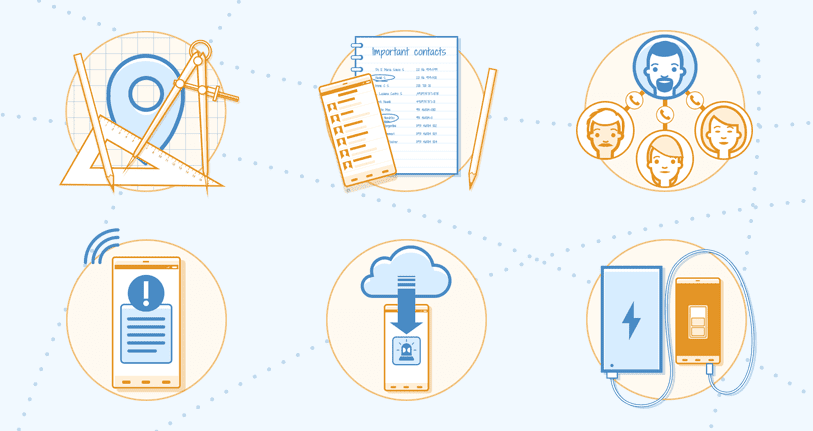Disasters can strike at any moment–are you prepared? Even with the number of COVID-19 communication tools at our disposal, many people didn’t have a plan in place ahead of the Coronavirus pandemic.
Nobody wants to think about something terrible happening, but unfortunately well-wishing doesn’t prevent catastrophic situations from occurring.
Whether it be a natural disaster, man-made disaster, or even a terrorist attack–you and your family need to be prepared for the worst so you can act quickly and decisively.
Preparation is essential to keeping your family safe during an emergency. There are two keys to being prepared for a disaster:
1. Have a pre-existing plan.
2. Have the right tools and devices to stay connected.
This guide will walk you through all the necessary steps to be adequately prepared and maintain communication during an emergency. We’ve also created a cheat sheet, so you can easily reference this information as you prepare your emergency plan.

One of the most important aspects of safely navigating a disaster scenario is communication.
Unfortunately, the standard communication channels are some of the first things to fail once catastrophe hits. There are a variety of reasons communication could be compromised, including:
- Strong winds or flooding damage cables between cellular towers.
- Seismic activity damages underground fiber-optic cables.
- Heavy rain or snow cuts off wavelength signals to important wireless links.
- Solar storms destroy cellular satellites.
- Networks become congested and jammed.
- Hackers disrupt or overload networks.
Any of these situations can make communication difficult.
Before disaster strikes, you need to have a firm, well-designed plan to avoid scrambling in the aftermath.
The time for planning is before a catastrophe happens, not during.
Take the following steps to ensure your family is prepared and safe in the event of an emergency.
- Create an emergency plan for your family and loved ones.
- Compile an emergency contact list of phone numbers.
- Establish a calling tree so all the phone calls don’t fall on one person.
- Subscribe to local text message alerts.
- Download helpful apps.
- Purchase backup charging options and keep one landline around for emergency communications in case of a power outage.
We’ll walk through each of these steps individually.
The first step in disaster preparedness is creating a family emergency plan.
You need to personalize your family plan to fit your unique family, but there are some basics that should be included:
1. Establish a rendezvous point – This could be your house or another secure location as long as everyone agrees on where it is.
2. Assign specific actions – Each family member should know which action they need to take in the event of an emergency (i.e. call/radio in, go home, or meet at the rendezvous point).
3. Create a clear hierarchy of communication channels – Make sure all family members know the communication plan in case one channel fails (e.g. cell phones > social media > email > phone booth > etc.).
4. Specify response times – Establish timelines for how long you family should wait until they head to the rendezvous point.
All disaster preparation starts with having an emergency plan.
You also need to create a contact list for emergency situations.
First and foremost, you need to include someone on this list who lives in a different part of the country. This is important because you want to have an emergency contact located outside the disaster zone in case it’s affecting a wide area, so you can still reach someone and communicate any important information. Other relevant contacts to include on this list are:
- Local police.
- Local fire department and first responders.
- Other relevant emergency services.
- Children’s school.
- Power company.
- Insurance company.
- Family members.
- Friends.
- Colleagues.
Essentially this list should include anyone whose safety is important and those that could be helpful during an emergency.
Another important step to preparing for a disaster is to establish a calling tree.
Establishing a calling tree is another reason to have an out of town person on your emergency contact list. The idea of a calling tree is simple: everyone calls into one designated caller to check-in, and that person relays information to everybody else.
Along with designating this person, you should also set an agreed upon timeframe for everybody to check-in. Through periodic check-ins you can keep track of how everyone is doing and where they are via the designated caller.
This person should have a copy of your family emergency plan to track everybody’s emergency response.
You want to gather as much information as possible when a disaster first strikes, especially since there’s a good chance your regular forms of communication could fail.
One way to ensure you’re getting updates as they happen is to subscribe to local text alerts. These alerts will notify you when something is happening in your community and continue to keep you updated on any new developments. Some potential options for text messaging alerts include:
- Weather
- Local government
- Children’s school district
- Local law enforcement
Some of these options may not be available for your area, but it’s worth considering during your preparations for a disaster response.
Applications can also be handy during an emergency.
In fact, there are several apps that are specifically designed for aiding you during a disaster scenario. Some apps worth downloading include:
- Red Cross – Suite of apps for general emergencies, tornadoes, hurricanes, earthquakes, wildfires, and floods.
- FEMA – Receive alerts from the National Weather Service and locate open shelters.
- ICE Standard Technologies – Provides emergency responders quick and easy access to your medical information.
- Disaster Alert – This is a global, multi-hazard monitoring and alerting application.
- Life360 – Allows you to create a personal network with family and friends to send messages and share locations.
- Twitter – Message friends and family and update your status.
- Facebook – Message friends and family and update status via Safety Check.
These apps can be lifesavers during an emergency, but expect network congestion. Keep some backup channels and phone lines available incase wifi or VoIP calling fails.
Apps and text alerts can be very helpful, but these tools are useless if your phone is dead.
To ensure your phone has power during an emergency you need to have plenty of backup charging options. Some potential options for charging your phone if the power goes out include:
- Mobile charging bank – If you have a power bank fully charged it will be able to charge your phone once, but of course, will need power after that.
- Car charger – You can use your car to charge your battery, but you’ll want to make sure you don’t kill your car battery.
- Solar charger – Solar powered chargers are an option, but these chargers are usually used as supplemental chargers.
- Hand-crank charger – These aren’t sustainable for a lasting charge, but can give you a quick burst to make a short call or send a vital text.
Having a charge for your phone is critical, especially if it’s your only means of communication. However, you shouldn’t solely rely on your phone during a disaster.
Since your cell phone may not be a viable option in an emergency, you need to have backup way to communicate. For example, amateur radio service, multi-use radio service, or walkie-talkies. Save the visual below as a reminder of what needs to be done to prepare for a disaster and the pros and cons of each communication method.















![What is Omnichannel Customer Service? [Benefits & Tips] What is Omnichannel Customer Service? [Benefits & Tips]](images/omni-channel-explained-350x203.png)

